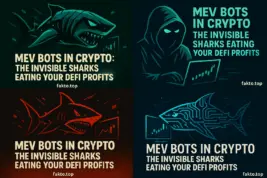Silent Bots, Loud Profit Losses
MEV Bots in Crypto: The Invisible Sharks Eating Your DeFi Profits
You think you’re trading like a pro on Uniswap, sniping low-cap gems and catching arbitrage waves? Think again. Behind the scenes, invisible bots are watching your every move — and they’re faster, smarter, and richer than you. These are MEV bots: algorithmic predators that front-run your trades, extract hidden profits, and manipulate block order to their advantage. They don’t just skim the surface — they feast on it. And unless you understand how they operate, you’re just another fish in their mempool. This article breaks down the mechanics, the players, and the future of MEV warfare — in plain English, with real analysis and zero fluff. Ready to see what’s really happening under the hood of DeFi?

What Is MEV and Why It’s the Dark Side of DeFi Trading
MEV stands for Maximal Extractable Value — a term that sounds academic but hides a brutal truth: bots are exploiting the blockchain’s architecture to profit off your transactions. Every time you submit a trade on a decentralized exchange (DEX), it enters the mempool — a public queue of pending transactions. MEV bots scan this mempool in real time, looking for juicy opportunities to front-run, back-run, or sandwich your trade.
Front-running means they insert their own transaction before yours, knowing it will move the price. Back-running means they follow your trade to catch the rebound. Sandwiching? That’s when they do both — buying before you, letting your trade pump the price, then selling right after. You get slippage. They get profit. And it’s all perfectly legal — because blockchains are transparent, permissionless, and ruthlessly efficient.
How MEV Bots Actually Work: Inside the Mempool Mechanics
The mempool is the blockchain’s waiting room. Every transaction sits there before being confirmed by validators. MEV bots monitor this space 24/7, using high-speed infrastructure and custom algorithms to detect profitable patterns. They don’t just react — they predict. If a whale is about to swap $2M worth of ETH to USDC, the bot knows that price impact is coming. It jumps in first, profits from the move, and exits before the whale’s transaction even hits the chain.
The key weapon here is gas. MEV bots bid higher gas fees to get their transactions included first. This is called a Priority Gas Auction (PGA). But the real game-changer is Flashbots — a private relay system that lets bots submit bundles of transactions directly to miners, bypassing the public mempool. This prevents other bots from copying their strategy and ensures execution. It’s like having VIP access to the blockchain’s backdoor.

Flashbots vs Public Mempool: Why Private Access Wins
Flashbots changed the MEV game. Before its launch, bots had to compete in the open mempool, often getting sniped by rivals. Flashbots introduced a private channel where bots could submit transaction bundles directly to miners. These bundles are atomic — they either execute fully or not at all. This gives bots precision, privacy, and protection.
But it also centralizes power. Flashbots now controls a significant portion of Ethereum’s blockspace. Critics argue it creates a cartel of privileged actors. Supporters say it reduces harmful MEV and improves efficiency. The truth? It’s both. Flashbots is a necessary evil — and it’s evolving fast.
SUAVE and the Future of MEV Infrastructure
Flashbots isn’t stopping at relays. Their next move is SUAVE — Single Unifying Auction for Value Expression. It’s a decentralized block builder that aims to democratize MEV extraction. Instead of private bundles, SUAVE lets anyone participate in the auction for blockspace. It’s like turning MEV into a public marketplace.
This could be revolutionary. SUAVE promises transparency, fairness, and composability. But it also introduces complexity. Will regular users understand how to bid for blockspace? Will whales dominate the auction? Will bots find new ways to exploit the system? SUAVE is still in development — but it’s the most ambitious MEV infrastructure project to date.
Is MEV a Decentralized Conspiracy?
Let’s be honest — the deeper you dig into MEV, the more it starts to feel like a decentralized conspiracy. Flashbots controls a massive share of Ethereum’s blockspace. SUAVE promises democratization, but it’s still built by the same players. Private relays, bundled transactions, and opaque auctions — all happening behind the scenes, while regular users get front-run and drained.

Some insiders argue that MEV is just the beginning — a glimpse into how blockspace itself could become the new Wall Street. Instead of bankers and brokers, we’ll have validators and bots. Instead of insider trading, we’ll have mempool sniping. And instead of regulation, we’ll have code — written by the few, executed by the many.
Is this paranoia? Maybe. But the facts are there. MEV extraction is real. The profits are massive. And the infrastructure is consolidating. If you’re not part of the bundle, you’re part of the slippage. So ask yourself — who really controls your transaction? And what happens when blockspace becomes the most valuable asset in crypto?
Real Impact on Users: Are You Losing Money to MEV Bots?
Short answer: yes. If you’ve ever traded on a DEX, you’ve probably been front-run. You just didn’t notice. MEV bots don’t leave fingerprints — they leave slippage. Your trade executes at a worse price. Your gas fee spikes. Your arbitrage fails. And the bot walks away with the profit.
This isn’t theoretical. Studies show that MEV extraction can cost users millions per day. In volatile markets, the impact is even greater. Bots target liquid pools, large trades, and predictable patterns. If you’re using MetaMask and clicking “Swap” without checking slippage or gas, you’re a target.
How to Protect Yourself from MEV Exploits
There’s no silver bullet, but there are strategies. Use limit orders instead of market orders. Trade during low-volume hours. Use aggregators like 1inch that route trades to minimize MEV exposure. Some wallets now offer “MEV protection” by routing through private relays. It’s not perfect, but it helps.
Also, stay informed. MEV is evolving fast. New bots, new strategies, new infrastructure. If you’re serious about DeFi, you need to understand the battlefield. Otherwise, you’re just another liquidity source for someone else’s algorithm.

MEV Bot Profit Strategies: What They Target and How
MEV bots aren’t just front-running trades. They’re liquidating positions, arbitraging price differences, and exploiting oracle delays. They operate across chains, using bridges and cross-chain messaging to find inefficiencies. Some bots even manipulate governance votes by timing their token purchases.
Here’s a breakdown of common MEV strategies:
| Strategy | Description | User Impact |
|---|---|---|
| Front-running | Bot places a trade before yours to profit from price movement | Worse execution price |
| Sandwich attack | Bot buys before and sells after your trade | High slippage, inflated price |
| Liquidation sniping | Bot monitors lending platforms for liquidation events | Gas wars, failed transactions |
| DEX arbitrage | Bot exploits price differences across exchanges | Minor impact unless you’re competing |
Are MEV Bots Good or Bad for Crypto?
It’s complicated. MEV bots provide liquidity, improve price discovery, and expose inefficiencies. But they also extract value from users, centralize power, and create unfair advantages. The crypto community is split. Some see MEV as inevitable — a natural consequence of transparent blockchains. Others see it as a threat to decentralization.
The real question is: can we design systems that minimize harmful MEV while preserving efficiency? Projects like SUAVE, EigenLayer, and MEV-Share are trying. But it’s a long road. And bots aren’t going anywhere.
Conclusion: MEV Awareness Is the First Step to Survival
MEV bots are here. They’re fast, invisible, and profitable. If you’re trading on-chain, you’re in their playground. But knowledge is power. By understanding how MEV works — and how bots exploit it — you can trade smarter, protect your assets, and maybe even build your own defenses.
This isn’t fear-mongering. It’s reality. MEV is the hidden layer of crypto economics. And the more you know, the less you lose. Stay sharp. Stay skeptical. And never assume the blockchain is playing fair.
| Tool | Purpose | MEV Risk Level |
|---|---|---|
| Uniswap | DEX for token swaps | High |
| 1inch | Aggregator with MEV protection | Medium |
| CowSwap | DEX using batch auctions to avoid MEV | Low |
| MetaMask + MEV Protection | Wallet with private routing options | Low to Medium |
| Flashbots | Private relay for MEV bundles | High (if you’re competing) |
| SUAVE | Decentralized MEV-aware block builder | Unknown (still in development) |
| EigenLayer | Restaking protocol with MEV mitigation potential | Emerging |
Final Thoughts: MEV Isn’t Going Away — So Adapt or Get Eaten
MEV is not a bug. It’s a feature — one that exposes the raw economics of blockchain infrastructure. Whether you love it or hate it, MEV is here to stay.
- Bots will keep evolving. Infrastructure will keep shifting. And users will either adapt or get eaten.
- The good news? Awareness is growing. Tools are improving. And the conversation is finally happening.
- If you’re building in crypto, trading on-chain, or just trying to stay ahead of the curve — understanding MEV is no longer optional. It’s essential. Learn the mechanics.
- Watch the trends. And don’t be afraid to ask hard questions.
- Because in the world of DeFi, the sharks aren’t just visible. They’re programmable.
